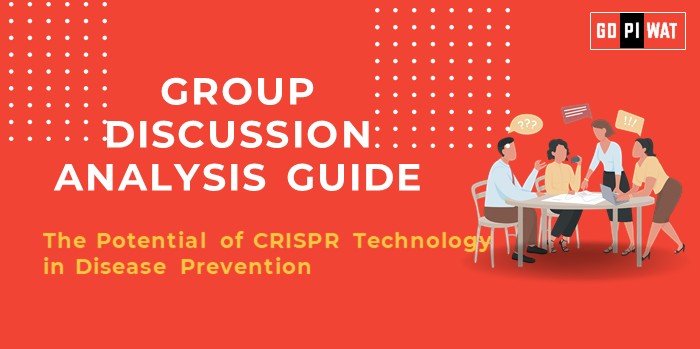📋 Comprehensive Analysis Guide: The Potential of CRISPR Technology in Disease Prevention
🌐 Group Discussion (GD) Analysis Guide
Introduction to CRISPR Technology
- Context Setting: CRISPR (Clustered Regularly Interspaced Short Palindromic Repeats) is a groundbreaking gene-editing tool with transformative potential in healthcare, agriculture, and beyond. It has redefined possibilities in preventing genetic diseases.
- Background: Discovered in 1987 and revolutionized by Jennifer Doudna and Emmanuelle Charpentier in 2012, CRISPR has evolved into a precise method to modify DNA. By 2024, clinical trials using CRISPR for diseases like sickle cell anemia and cancer are advancing rapidly.
📊 Quick Facts and Key Statistics
• First Approved Therapy: In 2020, CRISPR-based therapy received FDA approval for beta-thalassemia treatment.
• Cost of Therapy: CRISPR treatments can exceed $1 million per patient, emphasizing accessibility concerns.
• Research Funding: Over $3 billion invested globally in CRISPR research by 2023.
• Diseases Targeted: Over 40 clinical trials focus on genetic disorders like sickle cell disease and cancers.
• Market Size: The global CRISPR market is projected to reach $20 billion by 2030.
• Cost of Therapy: CRISPR treatments can exceed $1 million per patient, emphasizing accessibility concerns.
• Research Funding: Over $3 billion invested globally in CRISPR research by 2023.
• Diseases Targeted: Over 40 clinical trials focus on genetic disorders like sickle cell disease and cancers.
• Market Size: The global CRISPR market is projected to reach $20 billion by 2030.
🌟 Stakeholders and Their Roles
- 🏛️ Government Agencies: Fund research and regulate gene-editing practices to ensure safety.
- 💡 Biotech Companies: Innovate and commercialize CRISPR-based therapies.
- 🏥 Healthcare Systems: Integrate CRISPR treatments into clinical practice.
- ⚖️ Ethical Committees: Evaluate and guide the ethical implications of gene editing.
- 🤝 Patients and Advocacy Groups: Push for affordable access to treatments.
🏆 Achievements and Challenges
Achievements:
- ✅ Eradication of Genetic Diseases: Successful trials for conditions like sickle cell anemia.
- ✅ Precision Medicine: Personalizing treatment to genetic profiles.
- ✅ Oncology Breakthroughs: Early success in editing immune cells to fight cancer.
- ✅ Agricultural Impact: Enhancing disease resistance in crops.
Challenges:
- ⚠️ Ethical Concerns: Fear of designer babies and misuse.
- ⚠️ Accessibility: High costs and unequal distribution.
- ⚠️ Off-Target Effects: Risks of unintended DNA edits.
- ⚠️ Regulatory Hurdles: Diverse international laws complicate global progress.
🌍 Global Comparisons:
- 🇨🇳 China: Leading in CRISPR trials for cancer.
- 🇺🇸 USA: Strong emphasis on regulatory frameworks.
- 🇪🇺 Europe: Balanced focus on ethics and innovation.
📘 Case Studies:
- Victoria Gray’s Treatment: First U.S. patient cured of sickle cell anemia using CRISPR.
- He Jiankui Controversy: Unapproved editing of human embryos in China sparked global debate.
🗣️ Structured Arguments for Discussion
- 👍 Supporting Stance: “CRISPR can eradicate inherited diseases, revolutionizing healthcare.”
- 👎 Opposing Stance: “High costs and ethical dilemmas make CRISPR inaccessible and controversial.”
- ⚖️ Balanced Perspective: “CRISPR holds transformative potential but requires robust regulation and ethical safeguards.”
🎯 Effective Discussion Approaches
- 📌 Opening Approaches:
- “With over 40 active clinical trials, CRISPR is redefining disease prevention globally.”
- “CRISPR’s success in curing sickle cell anemia marks a pivotal moment in genetic medicine.”
- 📌 Counter-Argument Handling:
- Ethical: “Ethics committees worldwide are crafting guidelines to prevent misuse.”
- Accessibility: “Innovative financing models like public-private partnerships can reduce costs.”
📈 Strategic Analysis of Strengths and Weaknesses
- Strengths: High precision in genetic editing, broad applicability across diseases.
- Weaknesses: Expensive therapies, risk of misuse or off-target effects.
- Opportunities: Global leadership in biotechnology, collaborative international research.
- Threats: Ethical backlash, unequal access worsening health disparities.
🎓 Connecting with B-School Applications
- 📌 Real-World Applications: Case studies on CRISPR-based startups, operational strategies for scaling biotech innovations.
- ❓ Sample Interview Questions:
- “How can CRISPR bridge the gap between research and clinical application?”
- “What ethical safeguards are necessary for CRISPR?”
- 💡 Insights for B-School Students: Explore biotech financing models, research on CRISPR’s impact on healthcare costs and outcomes.


